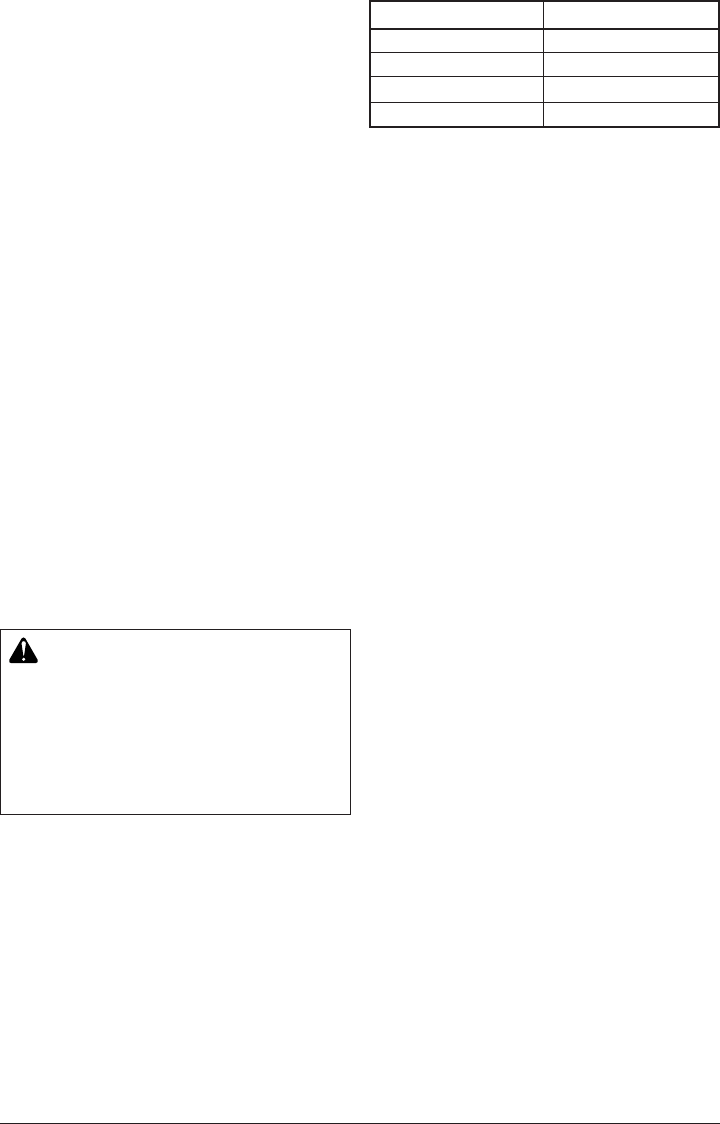
17
107705 www.desatech.com
2. On Model 107624-01, -02, turn adjusting screw
clockwise until slack is out of chain. On Model
107625-01, -02 turn thumb knob clockwise un-
til slack is out of chain (see Figure 7).
3. Wearing protective gloves, move chain around
guide bar. Chain should move freely. If chain
does not move freely, loosen chain by turning
adjusting screw counterclockwise.
4. After chain tension is correct, tighten guide bar
nuts firmly. If not, guide bar will move and loosen
chain tension. This will increase the risk of kick-
back. This can also damage saw.
Note:
A new
chain will stretch. Check new chain after first
few minutes of operation. Allow chain to cool
down. Readjust chain tension.
SAW CHAIN TENSION
ADJUSTMENT
Continued
FILLING OIL TANK
1. Remove oil cap.
2. Fill oil tank with SAE #30 motor oil.
Note:
For
temperatures below 30°F, use SAE #10 oil. For
temperatures above 75°F, use SAE #40 oil.
3. Replace oil cap at once. Tighten oil cap firmly for
good seal. This will avoid oil seepage from tank.
4. Wipe off excess oil.
Note:
It is normal for oil to seep when saw is not in
use. Empty oil tank after each use to prevent seepage.
OPERATING CHAIN SAW
EXTENSION CORDS
Use proper extension cords with this saw. Use only
extension cords marked for outdoor use. The cord
must be marked with suffix W or W-A following the
cord type designation.
Example:
SJTW-A or SJTW.
Use proper sized cord with this saw. Cord must be
heavy enough to carry current needed. An undersized
cord will cause voltage drop at saw. Saw will lose
power and overheat. Follow cord size requirements
listed below.
WARNING: Read and understand this
owner’s manual before operating this saw.
Make certain you read and understand all
Important Safety Information,
pages 2
through 4. Improper use of this chain saw
can cause severe injury or death from fire,
electrical shock, or body contact with mov-
ing chain, or falling wood.
Cord Length AWG Cord Size
25 feet 16 AWG
50 feet 16 AWG
100 feet 14 AWG
150 feet 12 AWG
Models EL-8: 107624-01, -02; 107625-01, -02
Keep cord away from cutting area. Make sure cord
does not catch on branches or logs during cutting.
Inspect cords often. Replace damaged cords.
This chain saw is designed with an extension cord
hitch that prevents the extension cord from being
pulled loose during use. To use, form a loop with the
end of the extension cord, insert loop into slot in rear
of handle, and place loop over cord hitch (see Figure
8). Gently pull loop against cord hitch until slack is
removed. Plug extension cord into chain saw cord.
OILING CHAIN
Manual Oil System
Always check oil level before using saw. Do not at-
tempt to operate the oil system while saw is in op-
eration. To oil chain, press squeeze bulb. Oil will
feed onto the guide bar and chain. Press squeeze bulb
at least once before each cut. Check oil level often
by looking at oil sight window (see Figure 9).
Automatic Oil System
Chain saw Model 107625-01, -02 is equipped with
an automatic oiling system. It will provide adequate
lubrication to the guide bar and saw chain. Check oil
level every 15 minutes of cutting time. Oil level can
be seen in oil sight window (see Figure 10).
CUTTING WITH THE CHAIN SAW
1. Connect saw to extension cord. Connect exten-
sion cord to power supply.
2. Make sure section of log to be cut is not laying
on ground. This will keep chain from touching
ground as it cuts through log. Touching ground
with moving chain will dull chain.
3. Use both hands to grip saw. Always use left hand
to grip front handle and right hand to grip rear
handle. Use firm grip. Thumbs and fingers must
wrap around saw handles (see Figure 11).
4. Make sure your footing is firm. Keep feet apart.
Divide your weight evenly on both feet.
5. When ready to make a cut, push the lockout button
completely forward with the right thumb and squeeze
the trigger (see Figure 11). This will turn saw on.
Releasing trigger will turn saw off. Make sure saw
is running at full speed before starting a cut.
6. When starting a cut, place moving chain against
wood. Hold saw firmly in place to avoid possible
bouncing or skating (sideways movement) of saw.
Continued


















